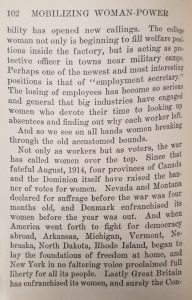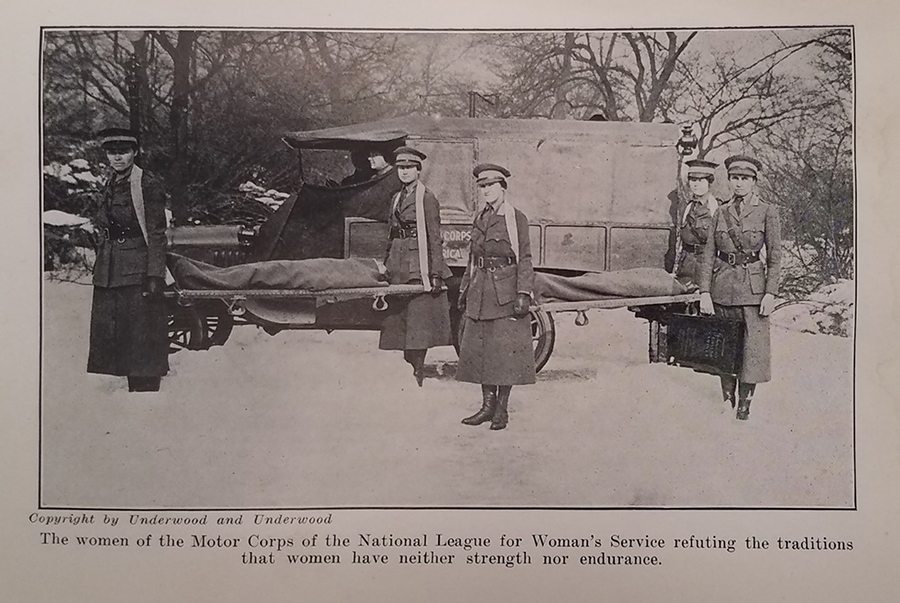Image from: Harriot Stanton Blatch
Mobilizing Woman Power.
New York: The Womans (sic) Press, 1918.
CELEBRATING WOMEN’S HISTORY MONTH
Since 1995, successive Presidents of the United States have issued annual proclamations to honor women each March for Women’s History Month.[1] What had begun in 1978 as a local celebration with students in Santa Rosa, California has become a national acknowledgment of the roles, accomplishments and contributions of women in society.[2] The foundation of these celebrations is rooted in International Women’s Day which has been observed annually on March 8 since the turn of the 20th century.[3]
This year’s theme for Women’s History Month is “Valiant Women of the Vote:  Refusing to be Silenced” in recognition of the centennial anniversary of the Suffrage Movement and the passage of the 19th Amendment which guarantees and protects women’s constitutional right to vote. On this occasion, women-centered institutions, organizations, and scholars from across the United States work to ensure this anniversary, and the 72-year fight to achieve it, are commemorated and celebrated nationally.[4]
Refusing to be Silenced” in recognition of the centennial anniversary of the Suffrage Movement and the passage of the 19th Amendment which guarantees and protects women’s constitutional right to vote. On this occasion, women-centered institutions, organizations, and scholars from across the United States work to ensure this anniversary, and the 72-year fight to achieve it, are commemorated and celebrated nationally.[4]
Harriot Eaton Stanton Blatch played a pivotal role in the fight for women’s voting rights.  The daughter of famous suffragette Elizabeth Cady Stanton and Henry B. Stanton, an abolitionist, politician and journalist, Blatch was uniquely positioned to champion the cause.[5] Though Blatch dedicated herself to women’s suffrage, she was also concerned with broader related issues of women’s economic power, independence and enfranchisement.[6] She wrote many books articulating her thoughts on the suffrage movement and the implications of free women in society. Some of the images in this blog post are from her book “Mobilizing Woman Power” published in 1918. The book emphasizes women’s contributions to World War I, which ended the year Blatch’s book was published. The volume focuses on women’s sacrifice for the war effort as well as their disenfranchisement.[7] That same year in the United Kingdom, where Blatch had lived for 20 years previously, women were granted the right to vote in Parliamentary Elections.[8] Labor strikes and movements made news around the world, and the Bolshevik Revolution spurred further momentum for women’s and labor rights.
The daughter of famous suffragette Elizabeth Cady Stanton and Henry B. Stanton, an abolitionist, politician and journalist, Blatch was uniquely positioned to champion the cause.[5] Though Blatch dedicated herself to women’s suffrage, she was also concerned with broader related issues of women’s economic power, independence and enfranchisement.[6] She wrote many books articulating her thoughts on the suffrage movement and the implications of free women in society. Some of the images in this blog post are from her book “Mobilizing Woman Power” published in 1918. The book emphasizes women’s contributions to World War I, which ended the year Blatch’s book was published. The volume focuses on women’s sacrifice for the war effort as well as their disenfranchisement.[7] That same year in the United Kingdom, where Blatch had lived for 20 years previously, women were granted the right to vote in Parliamentary Elections.[8] Labor strikes and movements made news around the world, and the Bolshevik Revolution spurred further momentum for women’s and labor rights.
These global events did not go unnoticed in the United States. With more women in the work force due to industrialization and the war effort, Blatch’s ideas gained traction with the larger public. In another interesting note about her book, the foreword was written by Theodore Roosevelt, a strong ally and visible partner for women’s rights since 1912. In the New York State Assembly, the trail-blazing Roosevelt introduced a bill to punish perpetrators of domestic violence against women and appointed women to executive positions in the government.[9]

Library of Congress, National American Woman Suffrage Association Collection, Rare Book and Special Collections Division (26,530)
Blatch also contributed a 100-page chapter to the book “History of Women’s Suffrage” on the subject of Lucy Stone’s American Woman Suffrage Association[10]. The organization was considered a rival to the National Woman Suffrage Association, founded by her mother and social reformer, Susan B. Anthony[11]. The volume was produced collectively by Elizabeth Cady Stanton, Susan B. Anthony, Matilda Joslyn Gage and Ida Husted Harper.[12] Published in six volumes from 1881 to 1922, it is a history of the women’s suffrage movement, primarily in the United States.

Image courtesy of the Library of Congress
https://loc.getarchive.net/media/in-the-days-of-old-dobbin-and-derby-hats-mrs-harriot-stanton-blatch-exhorted
The outspoken Harriot Eaton Stanton Blatch was affiliated with both the Women’s Trade Union League and her mother’s National American Woman Suffrage Association. In 1907, she founded the Equality League of Self-Supporting Women. Under her leadership the league enrolled thousands of working women who had never considered themselves political or rebellious. The burgeoning suffrage movement resulted in large, open-air meetings at which Blatch orated on the cause. On May 21, 1910, a mass parade down Fifth Avenue in New York City publicized the campaign, the first of many such public demonstrations which brought more visibility and support to the cause of women’s rights.[13] In her later years Blatch worked tirelessly for the passage of the Equal Rights Amendment (ERA), first drafted in 1923 by Alice Paul and Crystal Eastman and introduced in Congress in December 1923. Still not ratified into law, The ERA is a proposed amendment to the United States Constitution designed to guarantee equal legal rights for all American citizens regardless of sex. It seeks to end the legal distinctions between men and women in matters of divorce, property, employment, and other matters.[14] Blatch, who lived until November 20, 1940 would not see the passage of this amendment which has yet to be ratified over 80 years after her death.
The images and materials shown here are but a small part of the vast patrimony available to students, faculty and researchers. For access to this or other objects in our collections, complete a research request form to set up an appointment or contact us at 973-761-9476.
[1] https://www.womenshistory.org/womens-history/womens-history-month, accessed 3/2/2021.
[2] https://www.etonline.com/womens-history-month-how-it-started-and-how-to-celebrate-161258, accessed 3/2/2021.
[3] https://www.internationalwomensday.com/Activity/15586/The-history-of-IWD, accessed 3/2/2021.
[4] https://www.2020centennial.org/, accessed 3/2/2021.
[5] https://www.britannica.com/biography/Harriot-Eaton-Stanton-Blatch, accessed 3/2/2021.
[6] https://www.amazon.com/Harriot-Stanton-Blatch-Winning-Suffrage/dp/0300080689, accessed 3/2/2021.
[7] https://www.loc.gov/item/18012004/, accessed 3/2/2021.
[8] https://www.theguardian.com/gnmeducationcentre/2018/feb/05/womens-suffrage-february-1918-first-women-gain-right-to-vote-in-parliamentary-elections, accessed 3/2/2021.
[9] https://www.pbs.org/wgbh/americanexperience/features/tr-gable/, accessed 3/2/2021.
[10] https://www.britannica.com/biography/Harriot-Eaton-Stanton-Blatch, accessed 3/2/2021.
[11] http://www.crusadeforthevote.org/nwsa-organize, accessed 3/3/2021.
[12] https://en.wikipedia.org/wiki/History_of_Woman_Suffrage, accessed 3/3/2021.
[13] https://www.britannica.com/biography/Harriot-Eaton-Stanton-Blatch, accessed 3/3/2021.
[14] https://en.wikipedia.org/wiki/Equal_Rights_Amendment, accessed 3/3/2021.
